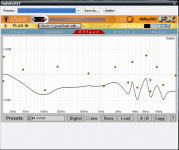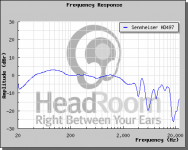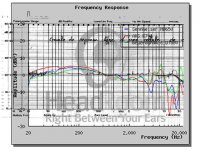If my PC is my source and i want to EQ my speakers does it make sense to use the equalizer on my PC or will it sound better using an equalizer hooked up to my PC? Using the equalizer in Media Player resulted in distortion. Are there better equalizers out there as a free download with better performance? Should I expect the same with an outboard unit? What are the advantages of one over the other.... or is it the same?
I've heard the iTunes EQ recommended, but havent tried it myself.
I have used a Behringer DEQ2496 and while I dont know if it sounds better than PC based EQ it does offer greater resolution than at least iTunes, i.e it can have filter widths down to 1/60 of an octave, not that you would ever need that.
With the DEQ, if you boost too much, which you shouldnt anyway, it will clip the signal and sound shite. Otherwise no complaints sound wise when feeding an external dac.
cheers
B.
I have used a Behringer DEQ2496 and while I dont know if it sounds better than PC based EQ it does offer greater resolution than at least iTunes, i.e it can have filter widths down to 1/60 of an octave, not that you would ever need that.
With the DEQ, if you boost too much, which you shouldnt anyway, it will clip the signal and sound shite. Otherwise no complaints sound wise when feeding an external dac.
cheers
B.
Godzilla,
Use VST plugins. It's by far the best solution I've found yet for things like this. I use foobar2000 for all my audio playback. Within it, I use the active DSP "George Yohng's VST Wrapper", which enables you to use multiple VST plugins simultaneously with Foobar. For EQ'ing, I use the "posihfopit" version of Aixcoustic Electri-Q.. by far the best I've found yet (when configured properly).
Assuming you're running a simple 2 channel setup, you're at a big advantage when it comes to stuff like this.. take advantage of it!
Use VST plugins. It's by far the best solution I've found yet for things like this. I use foobar2000 for all my audio playback. Within it, I use the active DSP "George Yohng's VST Wrapper", which enables you to use multiple VST plugins simultaneously with Foobar. For EQ'ing, I use the "posihfopit" version of Aixcoustic Electri-Q.. by far the best I've found yet (when configured properly).
Assuming you're running a simple 2 channel setup, you're at a big advantage when it comes to stuff like this.. take advantage of it!
For example, here's the crazy complicated nasty looking EQ curve I've been applying to my headphone setup for the last several months.. a pair of old Sennheiser HD-497's to a Presonus Central Station. Can't tell the difference between these and HD-600's now..
Attachments
A good PC-EQ will not sound worse than a good than a stand-alone EQ. The distortion you experienced was because you raised the volume of some frequencies over the maximum for Winamp. (when raising a band in a player like Winamp or Foobar you have to turn down the master volume of the player by the same amount).
I use the shibatch EQ for Wonamp and Foobar. It's FIR (I think it means it doesn't mess up the phase like other EQs do) and is very flexible. A little akward to use, though.
I use the shibatch EQ for Wonamp and Foobar. It's FIR (I think it means it doesn't mess up the phase like other EQs do) and is very flexible. A little akward to use, though.
dazydee said:I use the shibatch EQ for Wonamp and Foobar. It's FIR (I think it means it doesn't mess up the phase like other EQs do) and is very flexible.
You should see what those EQ's you speak of are actually doing to the response.. completely unusable IMO. It's more like a wide notch filter that you can't adjust.. or something. I used to use the Shibatch EQ for Winamp too, every day for many many years (back when I used Winamp).. until I started using VST plugins. There's absolutely no comparison. Use the right VST plugins correctly, and nothing else even comes close.
I was able to bring my inexpensive Pioneer B20's to another level in performance with a bit of EQ the other day. The problem was the distortion (i added a bass boost). The added bass sounded great on many recordings but also distorted badly on many as well. I am using a low powered Sonic Impact amp. Would using a more powerful amp allow the bass boost (to a point of course) and allow me to enjoy using EQ?
The subtle but effective changes in sound were really great!
The subtle but effective changes in sound were really great!
Godzilla said:Would using a more powerful amp allow the bass boost (to a point of course) and allow me to enjoy using EQ?
Yes, and yes..
I once had one of those little SI amps.. can't imagine trying to feed much low freq boost to it, I think it would have distorted like crazy. On the other hand, the EQ in Windows Media Player sucks worse than Windows Media Player itself, and that's pretty bad.
Use what I recommended above, along with a more powerful amplifier. If you spend enough time getting it right, you should end up with good results.
This is changing how i am thinking about my next speaker project... i quickly looked at Parts Express catalog and found some inexpensive Pyle Pro and Art Audio gear along with cheap equalizers... I wonder if this cheap pro gear will allow me to tailor the way my music sounds without losing the quality of sound from the SI amp. Any thoughts?
I can only agree with BHTX. Also use Foobar and VST, but I prefer Karma or Aqualizer eq - I find them easier to use. Again, setup correctly the difference is remarkable. Until recently I used a Behringer DEQ2496, without anything to compare it to it's still a good unit. But by comparison to eq in software the DEQ sounds muddy and puts a clamp on dynamics.
I use the DEQ to measure the room/speaker response and simply transfer the settings to the software eq. Although I recently came across REW from Home Theatre Shack -
http://www.hometheatershack.com/forums/rew-forum/
This software does all the DEQ does and more for free.
What I do miss is being able to eq both channels. Is anyone aware of a two channel VST eq with 31 points, i.e. 1/3 octave, or is there a way to run two mono VST eqs and use one for each channel ?
Jim
I use the DEQ to measure the room/speaker response and simply transfer the settings to the software eq. Although I recently came across REW from Home Theatre Shack -
http://www.hometheatershack.com/forums/rew-forum/
This software does all the DEQ does and more for free.
What I do miss is being able to eq both channels. Is anyone aware of a two channel VST eq with 31 points, i.e. 1/3 octave, or is there a way to run two mono VST eqs and use one for each channel ?
Jim
You can use the EQ of Foobar2000 and just after you push the "Auto Level" option, so the highest correction will be limited at +0dB and will not saturate your soundcard.
Now, if the output level of the card is high, it can also saturate your pre-amp input or even the amp in the case of insufisant power.
Now, if the output level of the card is high, it can also saturate your pre-amp input or even the amp in the case of insufisant power.
BHTX said:For example, here's the crazy complicated nasty looking EQ curve I've been applying to my headphone setup for the last several months.. a pair of old Sennheiser HD-497's to a Presonus Central Station. Can't tell the difference between these and HD-600's now..
How did you go about choosing this EQ curve?
Leglandu said:You can use the EQ of Foobar2000 and just after you push the "Auto Level" option, so the highest correction will be limited at +0dB and will not saturate your soundcard.
Now, if the output level of the card is high, it can also saturate your pre-amp input or even the amp in the case of insufisant power.
The standard Foobar EQ sucks balls.. don't use it. I wouldn't even call it an EQ. It doesn't even work like one. It's just crap.
tnargs said:
How did you go about choosing this EQ curve?
I used a combination of the signal generator in WinISD Pro (with "Get frequency from cursor" selected), a couple hundred sine wave test tone mp3's (to compare my changes), pink noise, and various other things.. carefully listening and tweaking off and on over a period of weeks.. until freq response to my ears seemed perfectly flat from 20 Hz - 20 KHz (ok, well more like 14-16 KHz, since that's as high as I can hear). Simply finding the most problematic areas with a signal gen and then using dozens of sine wave mp3's in foobar, going from bottom to top / top to bottom, and listening closely to make it flat got REALLY good results within the first couple of hours. All the rest was just minor tweaking here and there. Also, keep in mind that the EQ curve I posted above is using the nasty analog output of this old piece of trash onboard sound card. It's seriously one of the noisiest cards I've ever heard in my life. I believe it causes a bit of a boost around 100Hz too, among other things, which was obviously removed as well.
BHTX said:...... carefully listening and tweaking off and on over a period of weeks.. until freq response to my ears seemed perfectly flat from 20 Hz - 20 KHz (ok, well more like 14-16 KHz, since that's as high as I can hear). ....
If I understand, you used a subjective measurement technique. That is very interesting. It assumes that human hearing inherently hears equal sound pressure as equal loudness, regardless of frequency.
I thought the Fletcher-Munson curve demonstrated a different assumption is needed?
You cannot get a flat response without doing a RTA with the filter installed. I have done this and the result was disappointing. The sound was flat and lifeless.
When you EQ by ear, you wind up with a FR that is pleasing to your ear. Now, this is not a bad thing -- after all, you will have to listen to the thing. What you are doing is voicing your system and the room.
Voicing is an art form. You can get any sound you want. My choice is a slight BBC dipand a bit of a bass bump. Slightly warm sound. But, if you change to a different kind of amp, say SET to SS, you have to do the voicing all over again.
Bob
When you EQ by ear, you wind up with a FR that is pleasing to your ear. Now, this is not a bad thing -- after all, you will have to listen to the thing. What you are doing is voicing your system and the room.
Voicing is an art form. You can get any sound you want. My choice is a slight BBC dipand a bit of a bass bump. Slightly warm sound. But, if you change to a different kind of amp, say SET to SS, you have to do the voicing all over again.
Bob
tnargs said:If I understand, you used a subjective measurement technique. That is very interesting. It assumes that human hearing inherently hears equal sound pressure as equal loudness, regardless of frequency.
I thought the Fletcher-Munson curve demonstrated a different assumption is needed?
Yes, and of course I thought of all this beforehand. However, I went ahead and tried it this way, and ended up with good results. Remember, I'm talking about headphones here, not loudspeakers in a room. What's "flat" for headphones? There have been studies done in the past, but headphones still seem to remain an "art form" themselves. Show me what a "flat" curve for headphones to the average person's ear might look like, and I'll be happy to try it. It's not so easy though, because I also have to take into account the severely screwed up curve that these headphones already have (see below). They were always pretty rough in the upper mids, couldn't stand them.. but now, I can't tell the difference between these $50 cans from 5 years ago and a new pair of $300+ headphones. Actually, mine sound A LOT better, to be honest.
Sennheiser HD497 freq response:
Attachments
BHTX said:
Yes, and of course I thought of all this beforehand. However, I went ahead and tried it this way, and ended up with good results. Remember, I'm talking about headphones here, not loudspeakers in a room. What's "flat" for headphones? There have been studies done in the past, but headphones still seem to remain an "art form" themselves. Show me what a "flat" curve for headphones to the average person's ear might look like, and I'll be happy to try it. It's not so easy though, because I also have to take into account the severely screwed up curve that these headphones already have (see below). They were always pretty rough in the upper mids, couldn't stand them.. but now, I can't tell the difference between these $50 cans from 5 years ago and a new pair of $300+ headphones. Actually, mine sound A LOT better, to be honest.
Sennheiser HD497 freq response:
But, wouldn't it stand to reason that if you applied the same EQing technique to the $300+ headphones that they would improve as well? I'm not saying apply the same EQ curve but rather develop a new EQ curve for them the same way you did for the $50 headphones.
-Justin
>>> if you change to a different kind of amp, say SET to SS, you have to do the voicing all over again...
Along with the voicing being different, do you lose the other advantages the tube amp may have had? I am concerned about gritty sounding solid state and never being able to change that by using EQ. I wonder if setting up a solid state rig (something i have not had in many years - because i felt tubes sounded better) will leave me disappointed regardless of EQ or voicing.
>>> the same EQing technique to the $300+ headphones that they would improve as well?
That's an interesting question. I would guess the answer is yes, it would sound better. But if frequency responses are the same why would one pair of headphones or speakers sound different? If a $25 paper cone woofer was equalized to have the same frequency response as a $300 kevlar woofer how and why would they sound different?
Godzilla
PS. Bob, you look almost as handsome as i do in your new avatar.
Along with the voicing being different, do you lose the other advantages the tube amp may have had? I am concerned about gritty sounding solid state and never being able to change that by using EQ. I wonder if setting up a solid state rig (something i have not had in many years - because i felt tubes sounded better) will leave me disappointed regardless of EQ or voicing.
>>> the same EQing technique to the $300+ headphones that they would improve as well?
That's an interesting question. I would guess the answer is yes, it would sound better. But if frequency responses are the same why would one pair of headphones or speakers sound different? If a $25 paper cone woofer was equalized to have the same frequency response as a $300 kevlar woofer how and why would they sound different?
Godzilla
PS. Bob, you look almost as handsome as i do in your new avatar.
It's not only freq. response - phase response and cone stiffness (so it doesn't "break-up" and ring like a church bell on some freq.-s) are even more important. Also distortion, but the amount of it (according to Gedlee) apparently is not THAT important, rather the type and order of it (a rather complicated topic, has a lot to do with psychoacoustics).
- Status
- This old topic is closed. If you want to reopen this topic, contact a moderator using the "Report Post" button.


